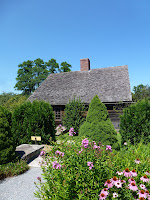Today we're happy to
welcome back author Kathleen Ernst. The Light Keeper’s Legacy
is Kathleen’s twenty-sixth published book. In addition to the Chloe Ellefson
series, she has written many books for American Girl, including seven books
about the newest historical character, Caroline Abbott. Several of her
mysteries for young readers have been finalists for Edgar or Agatha
awards.
Leave a comment for a chance to win any one of
Kathleen's Chloe Ellefson mysteries: Old World Murder,
The Heirloom Murders,
The Light Keeper’s Legacy, or Heritage of Darkness (October 2013).
For more information, visit Kathleen at her website or
blog. --
AP
Of
Mothers and Daughters
Threading plotlines over a multi-book arc is one of
the pleasures of writing a mystery series. While each of my Chloe Ellefson
Historic Sites books can stand alone, readers who follow the series in sequence
see relationships grow and change.
Curator Chloe Ellefson’s personal life has its
share of tangles. The third book in the series, The Light Keeper’s Legacy, begins with Chloe heading off for a
consulting gig and a week of much-craved solitude on a remote island. By the
end of a harrowing week, she’s ready to admit that sometimes, solitude ain’t
all it’s cracked up to be.
 |
| Vesterheim, Decorah, Iowa photo copyright D. T. Nelson, Oneota Fotos |
The next book, Heritage
of Darkness, allows her to make
good on her vow to improve family ties. Chloe’s relationship with her mother is
polite, but distant. Mom is a renowned practitioner of rosemaling, a decorative
form of Norwegian painting. When Chloe spots an ad announcing classes at
Vesterheim Norwegian-American Museum in Decorah, Iowa, she impulsively suggests
that she and Mom sign up for concurrent advanced and beginning classes.
Even better, Chloe’s cop-beau, Roelke McKenna,
decides to tag along. What could go wrong?
A lot, of course. Chloe is mortified when Mom
subjects Roelke to a not-so-subtle barrage of anecdotes about love and marriage,
Norwegian style.
 |
| Rosemaling |
And when an instructor is attacked and left for
dead, Mom is asked to teach the beginners. Roelke can see that Chloe is less
than pleased with the announcement that her oh-so-critical mother is now her instructor:
Chloe’s
expression suggested that she’d been smacked in the face with a pickled
herring. “Remember,” Roelke whispered, “the whole idea of this trip was for you
to spend time with…”
Chloe
pinned him to the wall with a look that had gone from stunned to mutinous. He
stopped talking.
Mom compounds the tension by volunteering Chloe for
a folklore project that involves interviewing elderly Norwegian-Americans about
Christmas customs and traditions.
Chloe
blinked. “You what? Mom, I’m a curator, not a folklorist!”
“For
Heaven’s sake, Chloe,” Mom said. “You work for the Historical Society of
Wisconsin. You’ve got a master’s degree in museum studies. You’ve been involved
in folklore your entire life.”
“But
I’m supposed to be painting, remember?” Something in Chloe’s eyes changed. “Or…do
you not want the daughter ‘who’s never picked up a brush’ in your class? Is
that it?”
Roelke
felt something crackle in the air like electricity before a storm. And at that
moment, he realized that he was a complete and utter moron. Why had he thought
he could help ease tension between Chloe, who he was only beginning to
understand, and her mother, who he barely knew? What had possessed him?
On one level, Heritage
of Darkness is a traditional mystery about a murdered painter and the dark
roots of now-cozy holiday traditions. However, it’s the personal relationships
that provide emotional connections for readers. I think many adult women will
relate to Chloe’s efforts to forge a stronger bond with her mother.
I might have chosen to end the book with Chloe and
Mom reaching a place of perfect harmony…but I didn’t. It would feel unrealistic
if Chloe’s relationship challenges were completely resolved. Progress is made,
but there’s still room for discovery and growth.
Besides, where would that leave me for the next
Chloe Ellefson mystery? I have lots of ideas about Chloe’s changing
relationship with her mom. (There’s Chloe’s relationship with Roelke to
develop, too.) Stay tuned!
Heritage of Darkness
For curator Chloe Ellefson, a
family bonding trip to Decorah, Iowa for rosemaling classes seems like a great
idea—until they start driving. Chloe’s cop boyfriend Roelke takes her mom’s
talk of proposal ideas good-naturedly, but it causes Chloe’s emotional distress
to increase with each passing mile.
After finally reaching the Vesterheim
Museum, Chloe’s efforts to remain positive are slammed shut when she and Roelke
find Petra Lekstrom’s body in one of the museum’s antique immigrant trunks.
Everyone is shaken by the class instructor’s murder, and when her mom
volunteers to take over Petra’s class, Chloe is put in the hot seat of motherly
criticism. As she investigates, Chloe uncovers dark family secrets that could be
deadly for her mom—and even herself.





.jpg)


























